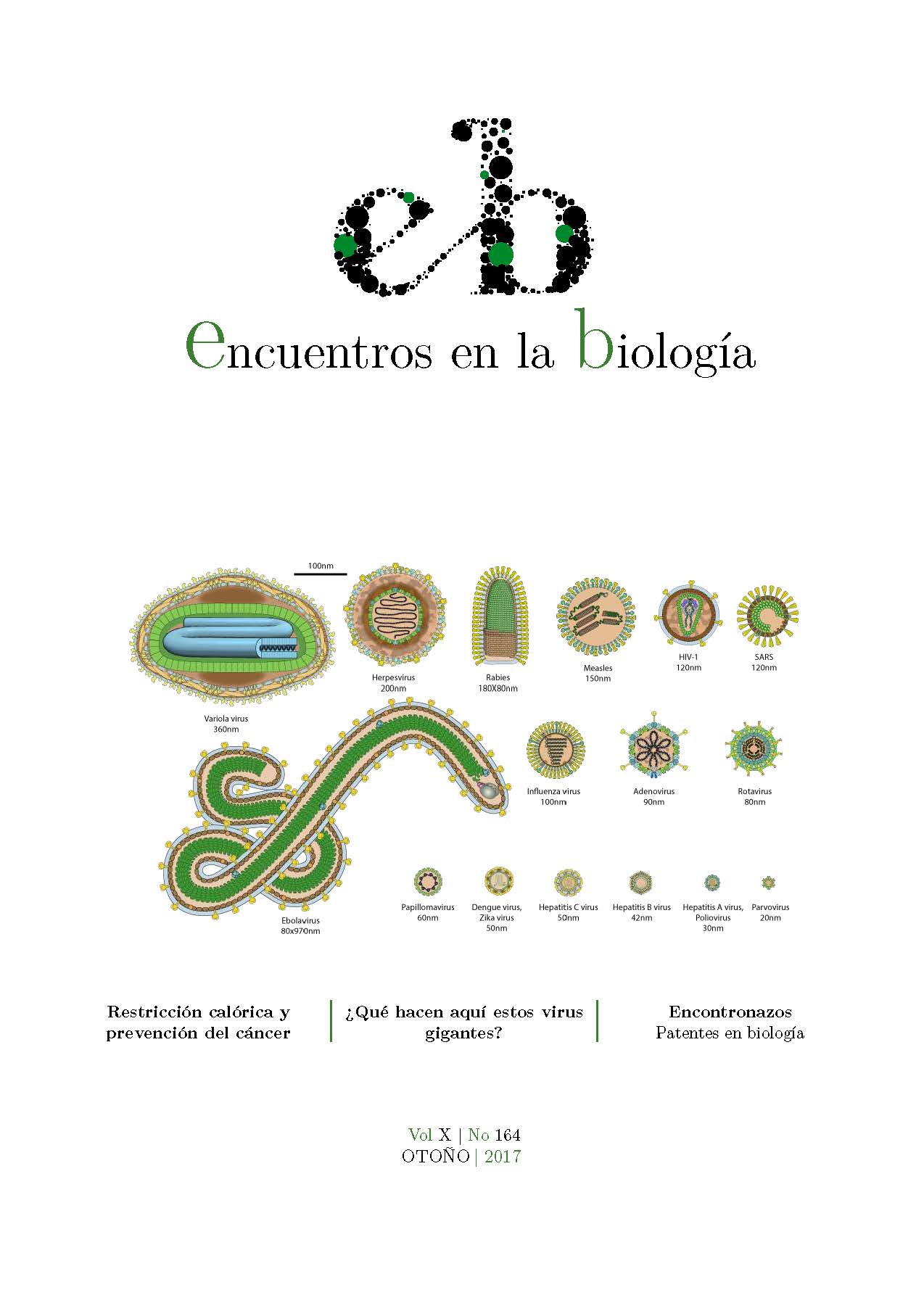What are these giant viruses doing here?: New aspects on the explanation of the origin and evolution of viruses
DOI:
https://doi.org/10.24310/enbio.v10i164.17509Keywords:
Megaviruses, origin and evolution of the viruses, philogenyAbstract
Megaviruses or giant viruses infect amoebas and exhibit remarkable features inside of the viral world. The sizes of their virions are between 2 and 15 times larger than the known large viruses, such as pox-, herpes- and iridoviruses, and their genomes contains about 50-250 times more genes, among which large proportions are unique amongst viruses, and a high proportion of them with unknown functions. Moreover, they enter amoebas through phagocytosis; no specific interaction with cell receptors is needed, unlike for traditional viruses. A major controversy is whether giant amoebal viruses comprise a fourth branch in the tree of life, aside Bacteria, Archaea, and Eukarya. No gene has been detected that is shared by all viruses, and only five major viral groups could be shown being monophyletic.
Downloads
Metrics
References
Abrahão J.S. y otros. 2014. Acanthamoeba polyphaga mimi- virus and other giant viruses: An open field to outstanding discoveries. Virol. J. 11: 120. doi:10.1186/1743-422X-11-120. 3La Scola B. y otros. 2008. The virophage as a unique parasite of the giant mimivirus. Nature 455: 100-104. doi:10.1038/nature07218.
Desnues C. y Raoult D. 2012. Virophages question the existence of satellites. Nat. Rev. Microbiol. 10: 234. doi:10.1038/nrmicro2676-c3.
Thomas V. y otros. 2011. Lausannevirus, a giant amoebal virus encoding histone doublets. Environ. Microbiol. 13: 1454- 1466. doi:10.1111/j.1462-2920.2011.02446.x
Philippe N. y otros. 2013. Pandoraviruses: Amoeba viruses with genomes up to 2.5 Mb reaching that of parasitic eukaryo- tes. Science 341 (6143): 281-286. doi:10.1126/science.1239181. 7Koonin E. V. y Dolja V. V. 2014. Virus world as an evo- lutionary network of viruses and capsidless selfish elements. Microbiol. Mol. Biol. Rev. 78: 278-303.
Durzynska J. y Gozdzicka-Josefiak A. 2015. Viruses and cells interwined since the dawn of evolution. Virol. J. 12: 169. doi:10.1186/s12985-015-0400-7.
Legendre M. y otros. 2015. In-depth study of Mollivirus sibericum, a new 30,000-y-old giant virus infecting Acant- hamoeba. Proc. Natl. Acad. Sci. U.S.A. 112: E5327–E5335. doi:10.1073/pnas.1510795112.
Reteno D. G. y otros. 2015. Faustovirus, an asfarvirus related new lineage of giant viruses infecting amoebae. J. Virol. 89: 6585-6589. doi:10.1128/JVI.00115-15.
Popgeorgiev N. y otros. 2013. Marseillevirus-like virus recovered from blood donated by asymptomatic humans. J. Infect. Dis. 208: 1042-1050. doi:10.1093/infdis/jit292.
Aherfi S. y otros. 2016. Giant viruses of amoeba: An update. Front. Microbiol. 7: 349. doi:10.3389/fmicb.2016.00349.
Legendre M. y otros. 2014. Thirty-thousand-year-old distant relative of giant icosahedral DNA viruses with a pandoravirus morphology. Proc. Natl. Acad. Sci. U.S.A. 111 (11): 4274- 4279. doi:10.1073/pnas.1320670111.
Schulz F. y otros. 2017. Giant viruses with an expanded complement of translation system components. Science 356 (6333): 82-85. doi:10.1126/science.aal4657.
Legendre M. y otros. 2012. Genomics of Megavirus and the elusive fourth domain of Life. Commun. Integr. Biol. 5: 102- 106.
Moreira D. y López-García, P. 2015. Evolution of viruses and cells: do we need a fourth domain of life to explain the origin of eukaryotes?. Phil. Trans R. Soc. B 370 (1678): 20140327. doi:10.1098/rstb.2014.0327.
Raoult D. 2013. TRUC or the need for a new microbial classification. Intervirology 56: 349-353. doi:10.1159/000354269.
Downloads
Published
How to Cite
Issue
Section
License
Esta obra está bajo licencia internacional Creative Commons Reconocimiento-NoComercial-CompartirIgual 4.0.
Esta revista provee acceso libre inmediato a su contenido bajo el principio de hacer disponible gratuitamente la investigación al público. Todos los contenidos publicados en Encuentros en la Bilogía están sujetos a la licencia Creative Commons Reconocimento-NoComercia-Compartirigual 4.0 cuyo texto completo puede consultar en <http://creativecommons.org/licenses/by-nc-sa/4.0>
Se pueden copiar, usar, difundir, transmitir y exponer públicamente, siempre que:
Se cite la autoría y la fuente original de su publicación (revista, editorial y URL de la obra).
No se usen para fines comerciales.
Se mencione la existencia y especificaciones de esta licencia de uso
Los derechos de autor son de dos clases: morales y patrimoniales. Los derechos morales son prerrogativas perpetuas, irrenunciables, intransferibles, inalienables, inembargables e imprescriptibles. De acuerdo con la legislación de derechos de autor, Encuentros en la Biología reconoce y respeta el derecho moral de los autores/as, así como la titularidad del derecho patrimonial, el cual será cedido a la Universidad de Málaga para su difusión en acceso abierto. Los derechos patrimoniales, se refieren a los beneficios que se obtienen por el uso o divulgación de las obras. Encuentros en la Biología se publica en open access y queda autorizada en exclusiva para realizar o autorizar por cualquier medio el uso, distribución, divulgación, reproducción, adaptación, traducción o transformación de la obra.
Es responsabilidad de los autores/as obtener los permisos necesarios de las imágenes que están sujetas a derechos de autor.
Los autores/as cuyas contribuciones sean aceptadas para su publicación en esta revista conservarán el derecho no exclusivo de utilizar sus contribuciones con fines académicos, de investigación y educativos, incluyendo el auto-archivo o depósito en repositorios de acceso abierto de cualquier tipo.
La edición electrónica de esta revista esta editada por la Editorial de la Universidad de Málaga (UmaEditorial), siendo necesario citar la procedencia en cualquier reproducción parcial o total.





